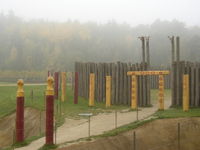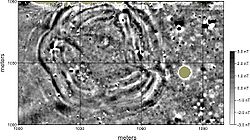- Circular ditches
-
About 150 arrangements of prehistoric circular ditches are known to archaeologists spread over Germany, Austria, Slovakia, and the Czech Republic. Their diameters range from ca. 20 to ca. 130 m, and they date to the 5th millennium BC. Tools, bones, and some artefacts were found in their context. The largest of these arrangements to date was found in Leipzig in the 1990s. Another large find was at the nearby village of Aythra, outside of Leipzig. From finds in the context of these ditches, and associated settlements of longhouses, it was established that they were in use for about 200 years, until roughly 4600 BC.
Contents
Background
The people that built these structures are associated with the Linear Ceramic culture. They appear to have lived in communal long houses and subsisted by farming cattle, goats, pigs, and sheep. The structures were built in a stretch of Central European land some 760 km (470 mi) across, over a period of one or two hundred years. They are believed to have migrated into this region during the 6th millennium BC from the plain of the Danube in what is now Hungary and Serbia. They made tools of wood, stone, and bone, and artwork of ceramic and pottery.
Function
An article in the British newspaper The Independent of June 11, 2005 identified these structures as "monumental temples", although there has been no scientific assessment of their purpose.
Pre-Columbian America
Similar structures have been identified during excavations of prehistoric sites of Wichita tribe. These structures, called "council circles", occur near the center of these sites, and previous archaeological excavations have suggested they consist of a central patio surrounded by four semisubterranean structures. The function of the council circles is unclear. Waldo Wedel[1] has suggested they may be ceremonial structures, possibly associated with solstice observations. Recent analysis suggests that many non-local artifacts occur exclusively or primarily within council circles, implying the structures were occupied by political and/or ritual leaders of the Great Bend aspect peoples.[2] Other archaeologists leave open the possibility that the council circle earthen works served a defensive role.[3]
See also
- Goseck circle
- Linear Ceramic culture
- Neolithic Europe
- Henge
References
- ^ Wedel, Waldo (1967). The Council Circles of Central Kansas: Were They Solstice Registers? American Antinquity 32, 54-63
- ^ Vehik, Susan C. 2002. Conflict, Trade, and Political Development on the Southern Plains. American Antiquity, 67(1), 37-64
- ^ Hollinger, Eric (2005). Conflict and Culture Change in the Late Prehistoric and Early Historic American Midcontinent. Unpublished PhD Dissertation. University of Illinois at Urban-Champaign
External links
Categories:- Monument types
- Stone Age Europe
- Archaeology of the United States
Wikimedia Foundation. 2010.


